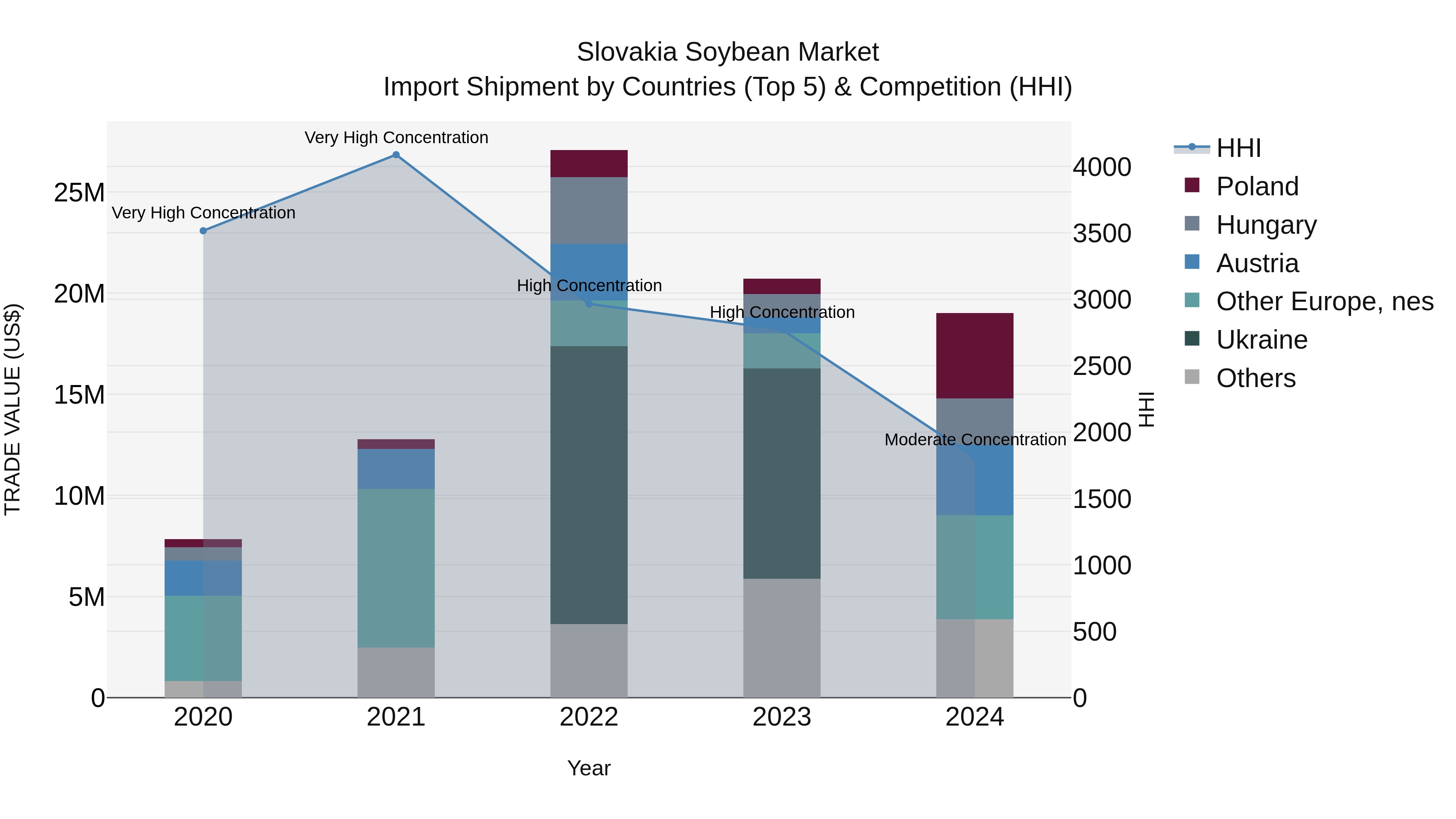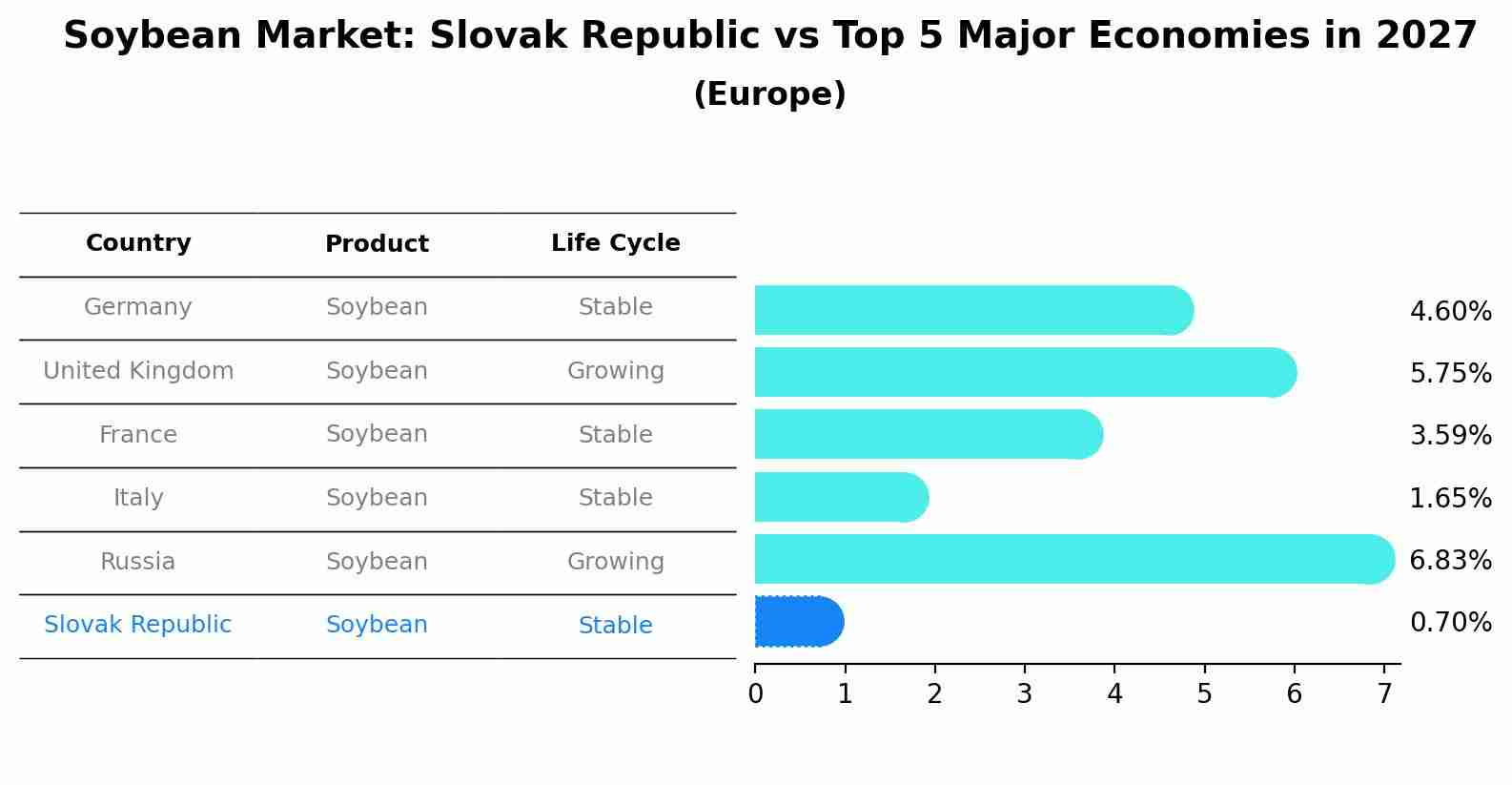Slovakia Soybean Market Outlook | Forecast, Growth, Size, Trends, Value, Share, Industry, COVID-19 IMPACT, Analysis, Companies & Revenue
| Product Code: ETC224660 | Publication Date: Aug 2022 | Updated Date: Nov 2025 | Product Type: Market Research Report | |
| Publisher: 6Wresearch | Author: Sumit Sagar | No. of Pages: 75 | No. of Figures: 35 | No. of Tables: 20 |
Slovakia Soybean Market Top 5 Importing Countries and Market Competition (HHI) Analysis
Slovakia`s soybean import Market Top 5 Importing Countries and Market Competition (HHI) Analysis saw a shift in concentration levels from high in 2023 to moderate in 2024, indicating increased diversification in import sources. Other Europe, nes, Poland, Austria, Hungary, and Germany were the top countries exporting soybeans to Slovakia in 2024. Despite a slight decline in growth rate from 2023 to 2024, the compound annual growth rate (CAGR) over the period 2020-24 was a robust 24.82%, reflecting a significant overall expansion in the soybean import Market Top 5 Importing Countries and Market Competition (HHI) Analysis. The changing dynamics suggest a competitive landscape and opportunities for strategic partnerships in the coming years.

Soybean Market: Slovak Republic vs Top 5 Major Economies in 2027 (Europe)
By 2027, the Soybean market in Slovak Republic is anticipated to reach a growth rate of 0.70%, as part of an increasingly competitive Europe region, where Germany remains at the forefront, supported by United Kingdom, France, Italy and Russia, driving innovations and market adoption across sectors.

Slovakia Soybean Market Overview
The Slovakia soybean market is characterized by steady growth driven by increasing demand for soybeans both in domestic consumption and livestock feed production. The country relies heavily on soybean imports to meet its needs, with key suppliers including the United States, Brazil, and Argentina. The market is influenced by factors such as global soybean prices, weather conditions impacting crop yields, and government policies related to agriculture and trade. Farmers in Slovakia are increasingly incorporating soybeans into their crop rotations due to its profitability and agronomic benefits. The food processing industry also plays a significant role in driving demand for soybeans in the form of soy-based products. Overall, the Slovakia soybean market is poised for further expansion with opportunities for increased production and trade partnerships.
Slovakia Soybean Market Trends
The Slovakia soybean market is experiencing steady growth due to the increasing consumer awareness of the health benefits associated with soy products. There is a rising demand for soybeans in various industries such as food processing, animal feed production, and biofuel manufacturing. Farmers in Slovakia are increasingly incorporating soybeans into their crop rotation due to their high protein content and versatility. The government`s support for sustainable agriculture practices and the promotion of soybean cultivation is also contributing to the market`s growth. Moreover, the growing popularity of plant-based diets among consumers is driving the demand for soy products, further fueling the expansion of the Slovakia soybean market.
Slovakia Soybean Market Challenges
In the Slovakia Soybean Market, one of the main challenges faced is the country`s limited production capacity, leading to high dependency on imports to meet domestic demand. This reliance on imports makes the market vulnerable to fluctuations in global soybean prices and supply chain disruptions. Additionally, fluctuating exchange rates and trade policies can further impact the profitability of soybean farmers and traders in Slovakia. Furthermore, the lack of advanced technology and infrastructure in the agricultural sector poses challenges in terms of efficiency and productivity. Overall, improving domestic production capacity, investing in technology, and diversifying import sources could help address some of the key challenges in the Slovakia Soybean Market.
Slovakia Soybean Market Investment Opportunities
The Slovakia Soybean Market presents various investment opportunities for interested investors. With the increasing demand for soybean products in the food, feed, and biofuel industries, there is a growing need for soybean cultivation and processing capabilities in Slovakia. Investors can consider opportunities in soybean farming, processing facilities, and trading activities to capitalize on this demand. Additionally, advancements in technology and sustainable agricultural practices offer the potential for increased efficiency and productivity in the soybean market. Collaborating with local farmers and industry experts can provide valuable insights and partnerships for successful investments in the Slovakia Soybean Market. Overall, investing in the Slovakia Soybean Market can offer promising returns for those looking to enter the agricultural sector in the region.
Slovakia Soybean Market Government Policy
The Slovak government does not have specific policies directly related to the soybean market. However, as a member of the European Union, Slovakia adheres to the common agricultural policy (CAP), which influences the production and trade of soybeans within the EU. Under the CAP, soybean farmers in Slovakia may receive subsidies and support for their production activities. Additionally, Slovakia may also be subject to regulations and trade agreements concerning soybeans that are negotiated at the EU level. Overall, while there are no distinct policies specific to the Slovak soybean market, the country`s participation in the CAP and compliance with EU regulations have implications for soybean producers and traders in Slovakia.
Slovakia Soybean Market Future Outlook
The future outlook for the Slovakia Soybean Market appears to be promising, driven by increasing consumer awareness of the health benefits associated with soy products and a growing demand for plant-based protein sources. As the trend towards healthier eating habits continues to gain traction in Slovakia, there is a rising interest in soybeans as a versatile and sustainable protein source. Additionally, the government`s initiatives to promote agricultural diversification and support local farmers could further boost soybean production in the country. However, challenges such as fluctuating global market prices, climate change impact on crop yields, and competition from other protein sources could also influence the market dynamics in the coming years. Overall, the Slovakia Soybean Market is poised for growth, but stakeholders should remain vigilant of the evolving market conditions.
Key Highlights of the Report:
- Slovakia Soybean Market Outlook
- Market Size of Slovakia Soybean Market, 2021
- Forecast of Slovakia Soybean Market, 2031
- Historical Data and Forecast of Slovakia Soybean Revenues & Volume for the Period 2018 - 2031
- Slovakia Soybean Market Trend Evolution
- Slovakia Soybean Market Drivers and Challenges
- Slovakia Soybean Price Trends
- Slovakia Soybean Porter's Five Forces
- Slovakia Soybean Industry Life Cycle
- Historical Data and Forecast of Slovakia Soybean Market Revenues & Volume By Applications for the Period 2018 - 2031
- Historical Data and Forecast of Slovakia Soybean Market Revenues & Volume By Crush for the Period 2018 - 2031
- Historical Data and Forecast of Slovakia Soybean Market Revenues & Volume By Feed Use for the Period 2018 - 2031
- Historical Data and Forecast of Slovakia Soybean Market Revenues & Volume By Food Use for the Period 2018 - 2031
- Slovakia Soybean Import Export Trade Statistics
- Market Opportunity Assessment By Applications
- Slovakia Soybean Top Companies Market Share
- Slovakia Soybean Competitive Benchmarking By Technical and Operational Parameters
- Slovakia Soybean Company Profiles
- Slovakia Soybean Key Strategic Recommendations
Frequently Asked Questions About the Market Study (FAQs):
1 Executive Summary |
2 Introduction |
2.1 Key Highlights of the Report |
2.2 Report Description |
2.3 Market Scope & Segmentation |
2.4 Research Methodology |
2.5 Assumptions |
3 Slovakia Soybean Market Overview |
3.1 Slovakia Country Macro Economic Indicators |
3.2 Slovakia Soybean Market Revenues & Volume, 2021 & 2031F |
3.3 Slovakia Soybean Market - Industry Life Cycle |
3.4 Slovakia Soybean Market - Porter's Five Forces |
3.5 Slovakia Soybean Market Revenues & Volume Share, By Applications, 2021 & 2031F |
4 Slovakia Soybean Market Dynamics |
4.1 Impact Analysis |
4.2 Market Drivers |
4.2.1 Increasing demand for plant-based protein sources |
4.2.2 Growing awareness about the health benefits of soybeans |
4.2.3 Government support and subsidies for soybean cultivation |
4.3 Market Restraints |
4.3.1 Vulnerability to weather conditions affecting crop yield |
4.3.2 Competition from other protein sources like pulses and lentils |
5 Slovakia Soybean Market Trends |
6 Slovakia Soybean Market, By Types |
6.1 Slovakia Soybean Market, By Applications |
6.1.1 Overview and Analysis |
6.1.2 Slovakia Soybean Market Revenues & Volume, By Applications, 2021-2031F |
6.1.3 Slovakia Soybean Market Revenues & Volume, By Crush, 2021-2031F |
6.1.4 Slovakia Soybean Market Revenues & Volume, By Feed Use, 2021-2031F |
6.1.5 Slovakia Soybean Market Revenues & Volume, By Food Use, 2021-2031F |
7 Slovakia Soybean Market Import-Export Trade Statistics |
7.1 Slovakia Soybean Market Export to Major Countries |
7.2 Slovakia Soybean Market Imports from Major Countries |
8 Slovakia Soybean Market Key Performance Indicators |
8.1 Average selling price of soybeans |
8.2 Percentage of agricultural land dedicated to soybean cultivation |
8.3 Number of new product launches containing soybeans in Slovakia |
9 Slovakia Soybean Market - Opportunity Assessment |
9.1 Slovakia Soybean Market Opportunity Assessment, By Applications, 2021 & 2031F |
10 Slovakia Soybean Market - Competitive Landscape |
10.1 Slovakia Soybean Market Revenue Share, By Companies, 2021 |
10.2 Slovakia Soybean Market Competitive Benchmarking, By Operating and Technical Parameters |
11 Company Profiles |
12 Recommendations |
13 Disclaimer |
- Single User License$ 1,995
- Department License$ 2,400
- Site License$ 3,120
- Global License$ 3,795
Search
Thought Leadership and Analyst Meet
Our Clients
Related Reports
- Afghanistan Apparel Market (2026-2032) | Growth, Outlook, Industry, Segmentation, Forecast, Size, Companies, Trends, Value, Share, Analysis & Revenue
- Canada Oil and Gas Market (2026-2032) | Share, Segmentation, Value, Industry, Trends, Forecast, Analysis, Size & Revenue, Growth, Competitive Landscape, Outlook, Companies
- Germany Breakfast Food Market (2026-2032) | Industry, Share, Growth, Size, Companies, Value, Analysis, Revenue, Trends, Forecast & Outlook
- Australia Briquette Market (2025-2031) | Growth, Size, Revenue, Forecast, Analysis, Trends, Value, Share, Industry & Companies
- Vietnam System Integrator Market (2025-2031) | Size, Companies, Analysis, Industry, Value, Forecast, Growth, Trends, Revenue & Share
- ASEAN and Thailand Brain Health Supplements Market (2025-2031) | Strategy, Consumer Insights, Analysis, Investment Trends, Opportunities, Growth, Size, Share, Industry, Revenue, Segments, Value, Segmentation, Supply, Forecast, Restraints, Outlook, Competition, Drivers, Trends, Demand, Pricing Analysis, Competitive, Strategic Insights, Companies, Challenges
- ASEAN Bearings Market (2025-2031) | Strategy, Consumer Insights, Analysis, Investment Trends, Opportunities, Growth, Size, Share, Industry, Revenue, Segments, Value, Segmentation, Supply, Forecast, Restraints, Outlook, Competition, Drivers, Trends, Demand, Pricing Analysis, Competitive, Strategic Insights, Companies, Challenges
- Europe Flooring Market (2025-2031) | Outlook, Share, Industry, Trends, Forecast, Companies, Revenue, Size, Analysis, Growth & Value
- Saudi Arabia Manlift Market (2025-2031) | Outlook, Size, Growth, Trends, Companies, Industry, Revenue, Value, Share, Forecast & Analysis
- Uganda Excavator, Crane, and Wheel Loaders Market (2025-2031) | Strategy, Consumer Insights, Analysis, Investment Trends, Opportunities, Growth, Size, Share, Industry, Revenue, Segments, Value, Segmentation, Supply, Forecast, Restraints, Outlook, Competition, Drivers, Trends, Demand, Pricing Analysis, Competitive, Strategic Insights, Companies, Challenges
Industry Events and Analyst Meet
Whitepaper
- Middle East & Africa Commercial Security Market Click here to view more.
- Middle East & Africa Fire Safety Systems & Equipment Market Click here to view more.
- GCC Drone Market Click here to view more.
- Middle East Lighting Fixture Market Click here to view more.
- GCC Physical & Perimeter Security Market Click here to view more.
6WResearch In News
- Doha a strategic location for EV manufacturing hub: IPA Qatar
- Demand for luxury TVs surging in the GCC, says Samsung
- Empowering Growth: The Thriving Journey of Bangladesh’s Cable Industry
- Demand for luxury TVs surging in the GCC, says Samsung
- Video call with a traditional healer? Once unthinkable, it’s now common in South Africa
- Intelligent Buildings To Smooth GCC’s Path To Net Zero


















